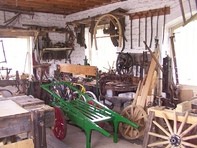Our group were fortunate with the weather, no rain and the sun shone most of the day – ideal for visiting an open-air museum.
Amberley Working Museum is an extensive 36-acre open-air museum, dedicated to the industrial heritage of South East England and with a special interest in aspects of the history of communications and transport, and disappearing manual trades and skills.
The site for the museum turned out to be a former chalk quarry where the chalk was converted into lime for use in mortar and cement, so there are several kilns remaining, with associated buildings – offices, cement bagging shed and locomotive shed. Also within the site, is the quarry tunnel (which appeared in the James Bond film A View to a Kill).
Rail enthusiasts were well-catered for, with the Amberley Museum Railway (narrow gauge), and the railway exhibition hall devoted to British industrial narrow gauge railways. There were 45 locomotives, (steam powered, internal combustion and battery electric), and around 80 items of rolling stock.
Visitors remembered the Southdown Coaches services– recalled by a 1920’s garage with 8 coaches.
The numerous exhibits and collections, mainly rescued from towns across the region, included an Earth telecommunications exhibition, an Energy Electricity Hall. Vintage Wireless and Communications exhibition, an Amateur radio station, and Rural telephone exchange. There were a range of workshops recalling disappearing skills – Wheelwright’s Shop, Machine Shop, Ironmonger’s shop, a metal foundry, Timber yard and Steam crane.
Fascinating rare and dying craft skills were on display – woodturning, broom-making, walking stick-making, caning, the blacksmith and stained glass maker – but none of the group decided to take up a new hobby.
Such a wide range of exhibits to interest visitors (many exhibits being retired after being used locally), that some visitors could have stayed longer.
A Brochure to the site helped everyone find their way around – even to the James Bond film set. Although much of the content appeared to be masculine-biased, it included many everyday subjects, so everyone, including Ladies, appeared to have enjoyed themselves, despite the catering service becoming overloaded.
 |  | |
 |
